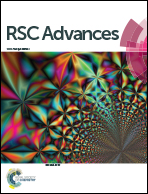Designing superhydrophobic surfaces with SAM modification on hierarchical ZIF-8/polymer hybrid membranes for efficient bioalcohol pervaporation†
Abstract
Inspired by the complementary roles of surface energy and roughness on natural nonwetting surfaces, a superhydrophobic surface has been successfully designed and prepared by self-assembled monolayer modification on a hierarchical ZIF-8/polymer hybrid membrane. The as-prepared membrane exhibited the best overall performance for n-butanol pervaporation.


 Please wait while we load your content...
Please wait while we load your content...